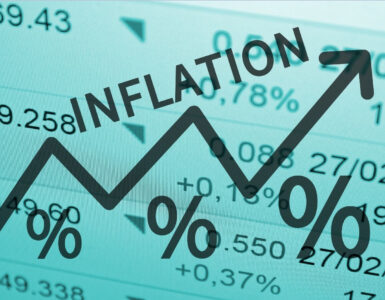All bad news is priced into the stock market, until it isn’t.
I lost count long ago the number of financial services pros that no matter what risks were barreling straight down on investors would tell me it was already priced into the valuations of public companies.
Back in late 2007 when two Bear Stearns (ticker symbol ‘BSC,’ for financial markets historians) hedge funds seemingly blew up out of nowhere, I remember making calls late at night from inside a conference room to contacts to find out what in the world was going on. “Nothing to see here, stocks will climb the wall of worry my friend,” is the general gist of how these calls collectively went.
We all know now what would happen next — bye-bye Bear Stearns, bye-bye Lehman Brothers, and almost bye-bye to the financial system. The S&P 500 went on to bottom out at 666 on March 9, 2009.
Leaving out many other examples of the bulls downplaying risk in the decade-plus since the Great Recession, I find myself at a similar crossroads today with the bulls — though the backdrop is one with far less worrying issues than back in 2008/2009. I have asked bulls about the impact to stocks as the Federal Reserve prepares to end its free money orgy in 2022.
“Fed tapering is all priced into the market, the S&P 500 is good to go baby.” OK.
I ask about our country again inching toward some form of government shutdown and if that will hit the markets. “Debt ceiling deals always get done last minute, stay hungry and stay diversified.” LOL.
I put forth a scenario where Evergrande isn’t bailed out by Chinese authorities, creating contagion to U.S.-based money managers with high exposure to emerging market debt. “Evergrande is just a Chinese real estate developer, it’s not that big of a deal — large asset managers won’t be forced to liquidate holdings into a nervous market.” Right, bruh.
What I want to tell you is that all of this market cheerleading is BS. And, risk is being underpriced by market goers. None of the factors I just mentioned are priced into the market, how could they be?
Take a gander at market valuations.
At about 22 times forward earnings, the S&P 500’s P/E ratio hasn’t been this elevated since late 2001, according to research from market sage Ed Yardeni. In case I am missing something — which is possible — there was no insanely unpredictable health pandemic raging in 2001 wreaking havoc on global business and a Fed bond buying program pumping up asset markets.
Then there are the earnings forecasts by the Street, which are a key element that supports stock prices. Currently they appear to be constructed by a bunch of folks that see S&P 500 5,500 in 2022. Analysts expect third quarter earnings for the S&P 500 to increase a heady 27.6%, per data from FactSet. If that number is hit or surpassed, it would mark the third highest year-over-year earnings growth rate reported by the index dating back to 2010.
All of this outsized optimism seems out of whack with 1) where we are in the pandemic; 2) the state of the government headed into October; and 3) the state of businesses. And that latter item is where I think will prove to be a big problem to markets as we enter yet another earnings season very soon in large part because of severely damaged global supply chains.
As The Wall Street Journal reports, our ports are brimming with excess containers (the byproduct of the unpredictable pandemic) collecting dust due to trucker labor shortages. Not only is that raising companies’ cost of doing business, but it’s harming their sales and clouding their ability to give guidance to investors.
The examples of these problems are beginning to pile up.
Nike: The sneaker and apparel maker warned last week the loss of production in COVID-19 stricken Vietnam is among several supply chain issues it is encountering. “We are not immune to the global supply chain headwinds that are challenging the manufacture and movement of product around the world,” Nike CFO Matt Friend told analysts on an earnings call. Nike went on to slash its full-year sales outlook, blaming supply chain challenges. Shares of the Dow component finished last week down 4.5%.
Costco: The warehouse retailer is having supply chain issues of its own. “We’re putting some limitations on key items like bath tissues, roll towels, signature water, high-demand cleaning-related skews related to the uptick in adults-related demand. Furniture delays in some shortages across traditional rollout times to go from eight to 12 weeks up to 16 to 18 weeks,” Costco CFO Richard Galanti said on an earnings call last week. Meanwhile, Costco is dealing with double-digit inflation in some product categories — which has weighed on profit margins. Costco’s stock fared better than Nike’s last week, rising 2.5% (analysts liked the company’s same-store sales trends and cash position).
FedEx: The mighty transportation giant had a terrible earnings day last week, thanks to supply chain issues and the inability to hire enough workers. FedEx said its quarterly results were drilled by $450 million due to labor shortages alone, notably at its ground segment. Execs estimated 600,000 packages across the FedEx network are being rerouted because of the inability to find labor. FedEx slashed its full-year profit outlook, sending the stock down 10% on the week.
If supply chain problems at these ginormous companies were priced into the stocks, then shares of Nike and FedEx would have GAINED on their earnings days. They didn’t, and now the Street is marking down their earnings estimates and their peer set.
“I think it’s a risk more to earnings. And if you think about it from a margin perspective, sort of any big hit that we make to profit margins can pull your EPS growth numbers down pretty significant,” RBC Capital Market’s Lori Calvasina told me on Yahoo Finance Live. Calvasina added that corporate commentary on supply chains has gotten “more alarmist” of late, and that her team is diving into why “supply chains are so bad.”
So, supply chains are the next problem for the bulls to pass off as no big deal — knowing them they will have an excuse ready to go. Just don’t pitch rose-colored glasses to me on Yahoo Finance Live, I have heard them all too many times.
Odds and ends
There will be no let up in corporate earnings this week as a few important names report.
Micron: The chip maker’s stock has treaded water since it last reported on July 1 as analysts voiced concern on inflationary costs. But headed into earnings this week, there could be a few near-term upside catalysts in play. For one is valuation — the stock is trading on a paltry 6.8 times forward P/E multiple despite strong demand for chips globally. Two, the company announced on Aug. 2 it initiated a quarterly dividend that will be paid out in mid-October to shareholders of record Oct. 1.
Paychex: If you are attempting to handicap the Oct. 8 non-farm payrolls report then pay careful attention to earnings this week from payroll servicer Paychex uniform seller Cintas. I liked what Paychex CEO Mary Mucci told me recently on Yahoo Finance Live about trends in his business.
CarMax: Shares are up 13% a month ahead of its earnings this week. As Carvana’s CEO Ernie Garcia explained to me, used car pricing has strengthened again (which is usually a good thing for used car sellers like Carvana and CarMax).
Bed Bath & Beyond: Its stock is down 20% in the past month, likely a result of soft summer retail sales and industry wide supply chain challenges for home furnishings. Bed Bath & Beyond CEO Mark Tritton is in the middle of transforming the retailer and has a lot of fans on Wall Street. Let’s see how the Street reacts to the company’s earnings day, it’s too tough to call.
Source: Yahoo Finance










